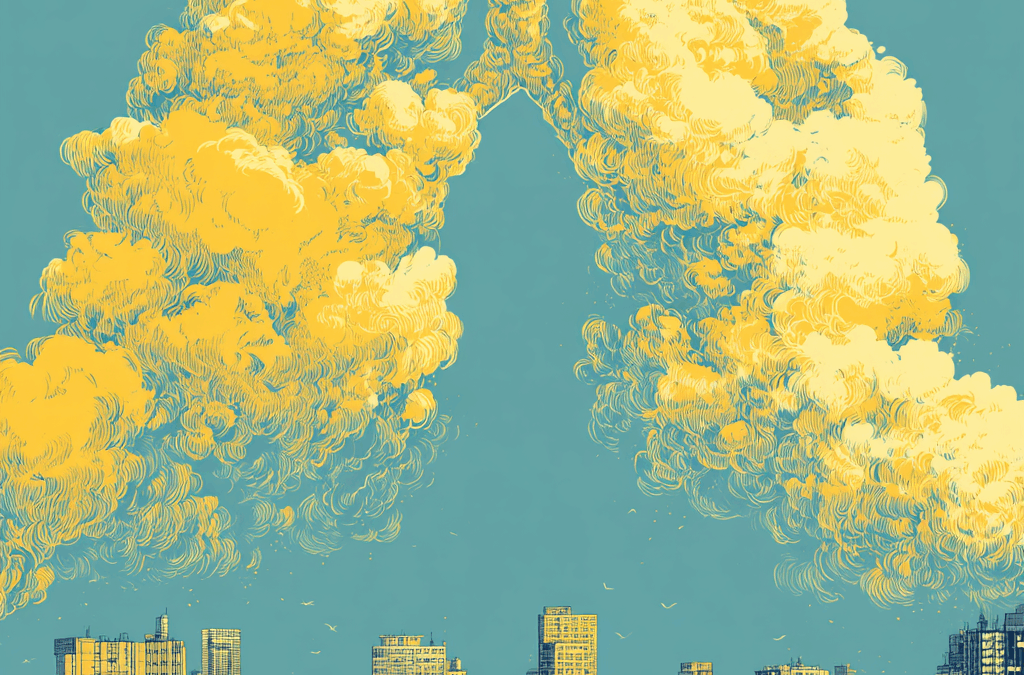
Why Lung Disease Is Rising Worldwide – Ch 2 – Breathe to Heal: How Nutrition and Lifestyle Can Save Your Lungs
Chapter 2: The Silent Crisis — Why Lung Disease Is Rising Worldwide
Breathe to Heal: How Nutrition and Lifestyle Can Save Your Lungs
The world is breathing harder.
From the smog-filled streets of Delhi to wildfire-choked skies in California, and from post-COVID fatigue in millions of homes to children wheezing through springtime allergies, we are living through a quiet epidemic — one that creeps into our lives with every breath.
Respiratory illness is now one of the top three causes of death worldwide, yet it receives a fraction of the attention that cancer or heart disease commands.
Unlike a heart attack, lung damage doesn’t always make headlines — it develops in whispers, over years of exposure, inflammation, and neglect.
This is the silent crisis of our time, and it’s affecting every generation.
🌍 A Global Snapshot of Declining Lung Health
According to the World Health Organization, over 545 million people currently live with a chronic respiratory disease.
-
COPD (Chronic Obstructive Pulmonary Disease) alone kills 3.2 million people each year.
-
Asthma affects 262 million people, many of them children.
-
Pneumonia remains the leading infectious cause of death for children under five.
These numbers are not slowing down — they’re accelerating.
And what’s even more concerning: respiratory issues are rising in younger, healthier populations who don’t smoke or have known medical risks.
What’s happening to our lungs? The answer lies in the way modern life has changed the air we breathe, the food we eat, and the way we live.
🏙️ 1. The Airborne Burden — Pollution and Particulates
Our lungs evolved to handle dust, pollen, and natural microbes — not microplastics, chemical fumes, or PM2.5 pollution.
The air quality crisis is now one of the leading environmental causes of death.
-
The World Bank estimates that air pollution costs the global economy over $8 trillion per year in healthcare and lost productivity.
-
PM2.5 particles, microscopic pollutants smaller than a red blood cell, penetrate deep into the lungs and bloodstream, causing inflammation that leads to asthma, COPD, and even heart disease.
-
In many major cities, breathing the air for one day is equivalent to smoking several cigarettes.
Even indoors, the air is far from safe. Household cleaners, synthetic fragrances, cooking oils, and mold release volatile organic compounds (VOCs) that quietly erode respiratory health.
This invisible assault is cumulative. Every breath counts — and so does every pollutant.
🍔 2. The Inflammation Diet — How Modern Food Fuels Lung Damage
Our lungs are deeply affected by what we eat. The connection between diet and respiratory health is one of medicine’s most overlooked frontiers.
The Western diet — heavy in sugar, refined oils, processed meats, and dairy — fuels systemic inflammation, which spreads to the delicate tissues of the lungs.
A 2023 study in The American Journal of Respiratory and Critical Care Medicine found that people who consumed high-sugar, low-antioxidant diets had 30% lower lung capacity than those who ate diets rich in fruits, vegetables, and omega-3 fats.
These inflammatory foods lead to oxidative stress, a buildup of harmful molecules that damage cellular structures in the respiratory tract.
Meanwhile, nutrient deficiencies — particularly vitamin D, magnesium, and zinc — weaken the immune system, leaving the lungs more vulnerable to infections and environmental toxins.
In short:
Our food can either stoke the fire of inflammation or cool it down.
Most modern diets are fanning the flames.
🧬 3. The Immune Overload — Autoimmunity and Viral Aftershocks
After decades of relative stability, we’re now seeing a rise in autoimmune and post-viral respiratory conditions.
COVID-19 reshaped the landscape of lung health — leaving behind millions of people struggling with long-term shortness of breath, fatigue, and inflammation long after the infection cleared.
These post-viral syndromes are partly caused by immune dysregulation: the body’s defense system becomes overactive and starts attacking its own tissues.
Similarly, autoimmune diseases like sarcoidosis, lupus, and rheumatoid arthritis often involve inflammatory reactions in the lungs.
The common denominator? A hyper-reactive immune system fueled by chronic stress, poor diet, and environmental exposure.
Our immune defenses are no longer at ease — they’re at war, often with ourselves.
🏠 4. The Indoor Generation — How Lifestyle Constricts the Lungs
We spend an average of 90% of our time indoors, often sitting for long periods in poorly ventilated spaces.
This combination — stagnant air, shallow breathing, and inactivity — weakens respiratory muscles and reduces lung elasticity.
Posture plays a major role.
When we hunch over screens, our diaphragm becomes compressed, and breathing shifts from the belly to the chest.
Over time, this leads to reduced oxygen exchange and reinforces a subtle sense of fatigue and anxiety.
Studies from the Cleveland Clinic show that sedentary lifestyles are directly linked to lower lung capacity, even in non-smokers.
The modern body is literally folding in on itself — and our breath is collapsing with it.
💊 5. The Chemical Cloud — From Cleaning Agents to Fragrances
Ironically, the very products marketed as “freshening” our environment often pollute it the most.
Household cleaners, air fresheners, scented candles, and even personal care items release volatile organic compounds (VOCs) that can irritate and inflame the respiratory tract.
Exposure to these substances can trigger headaches, coughing, wheezing, and, in sensitive individuals, chronic asthma-like symptoms.
A 2024 Environmental Health Perspectives review concluded that prolonged exposure to household VOCs increases the risk of developing asthma by up to 37%.
The average home now contains over 500 different synthetic chemicals, many untested for long-term respiratory safety.
The lungs, constantly filtering 10,000 liters of air daily, bear the brunt of this hidden chemical storm.
🧘 6. The Stress Epidemic — When Anxiety Steals Your Breath
There’s a reason we say, “Take a deep breath.”
Stress instantly changes how we breathe — shortening our inhalations and speeding up our exhalations.
This chronic tension keeps the body in a state of fight-or-flight, which elevates inflammation and tightens the respiratory muscles.
Over time, people under continuous stress may unconsciously adopt rapid, shallow breathing patterns that mirror anxiety itself.
Psychologists now call this the “stress-breath cycle” — a self-reinforcing loop where emotional strain alters breathing, and disordered breathing fuels more emotional strain.
Chronic stress doesn’t just affect the mind — it literally constricts the breath of life.
🌡️ 7. The Climate Factor — When the Planet Can’t Breathe Either
Global warming isn’t only a political or environmental issue — it’s a public health emergency.
Rising temperatures increase pollen seasons, wildfire frequency, and ozone levels, all of which aggravate respiratory symptoms.
Each degree of warming worsens air quality, increasing hospital admissions for asthma and COPD.
A Lancet Planetary Health study predicts that by 2050, climate-related respiratory illness will surpass malnutrition as a cause of early death in many regions.
When the planet struggles to breathe, so do we.
💬 A Crisis Hidden in Plain Sight
What makes this epidemic so insidious is that it rarely announces itself.
A cough here. A bit of shortness of breath there.
Most people adapt, ignoring the signs until a crisis forces them to pay attention.
We have normalized poor breathing and declining lung function — much like we’ve normalized fatigue, stress, and fast food.
The silent crisis of lung health is not just medical — it’s cultural.
It reflects the modern disconnection between how we live and what keeps us alive.
🌱 The Good News: It’s Reversible
The lungs are extraordinary healers. Within weeks of improving air quality, diet, and breathing patterns, measurable improvements occur in oxygen levels and inflammation markers.
New alveoli can form. Inflammation can subside. Breath capacity can expand.
Your body is constantly renewing itself — including your lungs.
The key lies in changing the internal and external environments that shape how they function.
In the chapters ahead, we’ll explore how to do just that — through nutrition, detoxification, movement, and conscious breathwork.
The air outside may be beyond your control.
But the air inside your body — that’s where your power begins.
🔑 Key Takeaway
The modern respiratory crisis is driven by pollution, diet, lifestyle, and stress — but it’s not irreversible. By addressing the root causes, you can transform your breath and your health.




